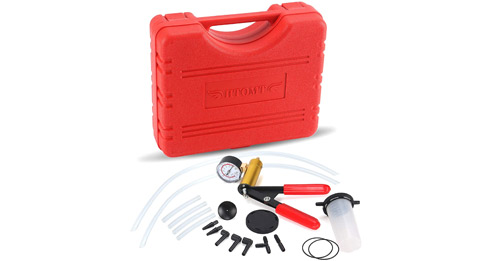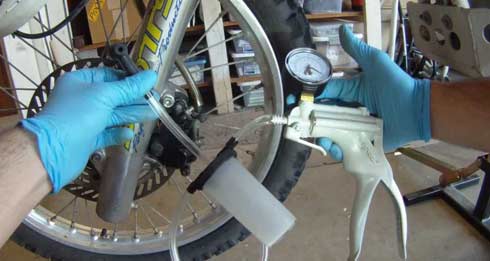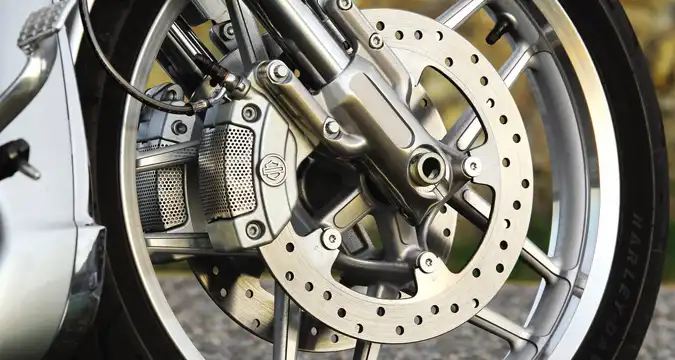Your motorcycle’s front brakes are essential for stopping quickly and safely. If they’re not working correctly, you could find yourself in a dangerous situation.
It can be tricky to know how to bleed your motorcycle’s dual front brakes properly. If you don’t do it right, you could end up with air bubbles in the brake lines that will reduce your braking power.
We’ve got the ultimate guide on how to bleed motorcycle dual front brakes correctly. With our easy step-by-step instructions, you’ll be able to get your bike’s brakes back in top condition in no time!
What is Motorcycle Dual Front Brakes?

Motorcycle dual front brakes consist of two separate brake systems for each front wheel. These are connected, so both wheels will be activated simultaneously when applying the brake lever or pedal.
You’ve probably heard that it’s important to get your motorcycle regularly serviced to keep it in good condition. The same thing goes for your brakes. If you don’t keep an eye on them and make sure they’re in top condition, it could be dangerous to ride.
Steps for How to Bleed Motorcycle Dual Front Brakes
There are a few different ways to bleed your brakes. You can do this with a special brake bleeding kit that will attach to one of the wheel cylinders, or you can use a hand pump and go from there. Below we will explain how each method works:
Bleeding the Brakes Using a Brake Bleeding Kit

You should always wear protective gloves when doing this job. Before you begin, make sure the motorcycle’s engine is turned off, so there’s no chance of accidental contact with the moving parts.
1) Loosen one of the front brake screws until it completely comes out of the handlebar. This will allow you to access the bleed screw on one of your wheel cylinders. Just remove the screw completely.
2) Loosen the bleed screw by about half a turn with the pencil-type tool provided in your brake bleeding kit. This is where you’ll attach one of the plastic tubes that will let the air escape from your brakes. If you don’t have this small part, you can use a thin piece of wire or tweezers instead.
3) Line up the tube with the bleed screw so that it forms an airtight seal. When you have it in place, pump the rubber bulb of your hand pump to create pressure inside your brake lines. Keep checking on the fluid coming out so you know when all of the air bubbles have disappeared, and only clean brake fluid is coming out. You can take the tube off and screw the bleed screw back into place as soon as this happens.
4) Repeat these steps for your other front wheel cylinder. If you want to be really thorough, do this process a total of three times with each wheel to make sure all of the air bubbles have been removed from your brake lines.
Bleeding the Brakes Using a Hand Pump

1) This is a slightly trickier but still possible option if you’re working with a motorcycle that doesn’t feature a bleed screw on its wheel cylinders (such as some older models). You’ll need to clamp one end of your rubber hose onto the caliper and stick the other end into a small bottle with brake fluid.
2) Make sure the hose is sealed properly, so you don’t get any air in there. Pump up your hand brake several times to build pressure inside the lines with the motorcycle’s engine off. This should push all of the air bubbles out through the hose and into your bottle. If it’s not working, try clamping the hose onto another part of the caliper to make sure all of it is getting filled with brake fluid.
3) After you’ve built up enough pressure inside your lines, take off the hose from the caliper and twist a little knob on top of your brake fluid bottle counterclockwise. This will let any excess fluid come spilling out.
4) Now, your brakes should be fully bled and ready to go! You can replace the screw on your brake lever or pedal, do up the bolts progressively so you don’t break them, and ride off into the sunset with perfectly-working brakes once again!
Bleeding the Brakes Using a Suction Pump

1. Loosen one of the front brake screws until it completely comes out of the handlebar. This will allow you to access the bleed screw on one of your wheel cylinders. Just remove the screw completely.
2. Loosen the bleed screw by about half a turn with the pencil-type tool provided in your brake bleeding kit. This is where you’ll attach one of the plastic tubes that will let the air escape from your brakes. If you don’t have this small part, you can use a thin piece of wire or tweezers instead.
3. Line up the tube with the bleed screw to form an airtight seal. When you have it in place, pump the rubber bulb of your hand pump to create pressure inside your brake lines. Keep checking on the fluid coming out, so you know when all of the air bubbles have disappeared, and only clean brake fluid is coming out. You can take the tube off and screw the bleed screw back into place as soon as this happens.
4. Repeat these steps for your other front wheel cylinder. If you want to be really thorough, do this process a total of three times with each wheel to make sure all of the air bubbles have been removed from your brake lines.
5. Now your brakes should be fully bled and ready to go! You can replace the screw on your brake lever or pedal, do up the bolts progressively, so you don’t break them, and ride off into the sunset with perfectly-working brakes once again!
You will no longer have to worry about riding with old, ineffective brakes. With the right technique and patience, you’ll be able to bleed your motorcycle’s dual front brakes in no time!
Bleeding Motorcycle Dual Front Brakes: Tips and Tricks
Now that you know more about motorcycle front brakes, here are some things you can do to make sure they stay in optimal condition. Take note of the following tips and tricks:
- If you want to replace your brake pads, do it when your motorcycle is parked on a flat surface so you won’t have to work against gravity.
- Keep the handlebars steady at all times – this will ensure that all of the brake lines remain intact and undamaged.
- If you need help with bleeding your brakes or replacing your brake pads, ask for help from another person.
- Wear gloves at all times to protect your hands from any foreign debris or spills that might occur.
- Always use the correct type of brake fluid to avoid causing damage to your vehicle. Fluids that have been opened or have gone stale will not function properly, so always make sure they’re fresh before using them on your bike.
- Keep all tools away from children. They can be dangerous if they fall into the wrong hands.
- Closely follow all safety precautions and wear protective clothing to cover your arms, legs, and face. This is a necessary step you need to take if you want to avoid being injured from any debris or chemicals that might come in contact with your skin.
Motorcycle front brakes are important because they allow the rider to control the speed at which his or her bike is traveling.
Always make sure that your front brakes are working properly by checking them often and taking care of any issues that might arise.
The Importance of Motorcycle Front Brakes
The front brake is responsible for stopping the forward momentum of your bike. With this in mind, it’s important always to make sure that your brakes are working properly so you don’t crash or get into an accident when riding over rough terrain.
Here are some things you should know about motorcycle front brakes:
1) They’re more powerful than the rear brake. When you’re braking, the front tire will have a larger amount of weight pushing down on it. This is why motorcycle manufacturers prioritize making your front brakes more powerful than your back brake.
2) They should be bled if they’re starting to fail. If you notice that your front brakes are not performing as well as they used to, make sure to bleed them immediately before it’s too late.
3) They should be checked often to make sure they won’t malfunction while riding. Front brakes are extremely important because if they fail for any reason, it could be a fatal mistake.
Every time you ride your bike or go out for a spin, make sure to check the condition of your front brakes. Look for loose bolts and damaged brake lines as well as fluid leaks – these are some of the most common reasons why a motorcycle’s front brakes fail.
Conclusion
Motorcycle front brakes are extremely important for safe riding. Furthermore, keeping your motorcycle’s front brakes in good condition is always important.
Whenever you suspect they are malfunctioning or the brake fluid is low, take a look at them and make any necessary repairs as soon as possible. By following the tips and tricks in this article, you can make sure that your brakes are always in optimal condition. Remember to bleed them if they start to malfunction and never ride without checking their condition first!

